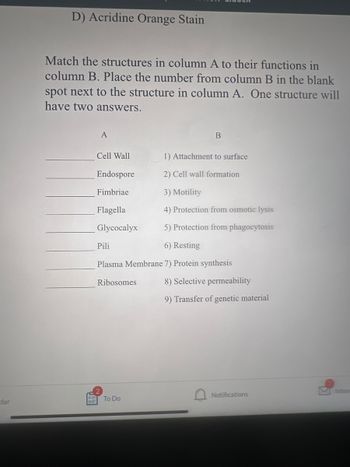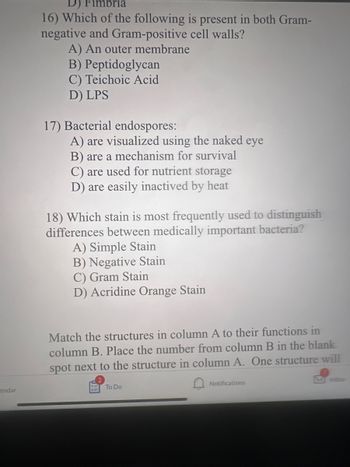
Human Anatomy & Physiology (11th Edition)
11th Edition
ISBN: 9780134580999
Author: Elaine N. Marieb, Katja N. Hoehn
Publisher: PEARSON
expand_more
expand_more
format_list_bulleted
Concept explainers
Question
What are the answers to these questions?

Transcribed Image Text:dar
D) Acridine Orange Stain
Match the structures in column A to their functions in
column B. Place the number from column B in the blank
spot next to the structure in column A. One structure will
have two answers.
A
Cell Wall
Endospore
Fimbriae
Flagella
Glycocalyx
Pili
6) Resting
Plasma Membrane 7) Protein synthesis
Ribosomes
B
To Do
1) Attachment to surface
2) Cell wall formation
3) Motility
4) Protection from osmotic lysis
5) Protection from phagocytosis
8) Selective permeability
9) Transfer of genetic material
Notifications

Transcribed Image Text:endar
D) Fimbria
16) Which of the following is present in both Gram-
negative and Gram-positive
cell walls?
A) An outer membrane
B) Peptidoglycan
C) Teichoic Acid
D) LPS
17) Bacterial endospores:
A) are visualized using the naked eye
B) are a mechanism for survival
C) are used for nutrient storage
D) are easily inactived by heat
18) Which stain is most frequently used to distinguish
differences between medically important bacteria?
A) Simple Stain
B) Negative Stain
C) Gram Stain
D) Acridine Orange Stain
Match the structures in column A to their functions in
column B. Place the number from column B in the blank
spot next to the structure in column A. One structure will
To Do
Notifications
Expert Solution
This question has been solved!
Explore an expertly crafted, step-by-step solution for a thorough understanding of key concepts.
This is a popular solution
Trending nowThis is a popular solution!
Step by stepSolved in 4 steps

Knowledge Booster
Learn more about
Need a deep-dive on the concept behind this application? Look no further. Learn more about this topic, biology and related others by exploring similar questions and additional content below.Similar questions
- Question 2arrow_forwardQUESTION 39 Treatment of Diabetes Insulin administration is a primary course of treatment for which type of diabetes? а. type 2 b. prediabetes c. gestational d. type 1arrow_forwardQuestion 2 While going for a quiet walk in the woods, you suddenly come across a very angry bear, a) How does your body immediately respond ? Provide 3 examples. b) What glands and hormones are involved in this response? c) How would your body respond in a situation of prolonged stress due to your work environment. Describe what hormones and glands would be responsible as well as two examples of changes that may take place your body.arrow_forward
- Please answer this with the simplest answer , Please bolt the important answerarrow_forwardQUESTION 32 Physiological processes have optimal conditions for functioning, and outside of that optimum, environmental changes can result in decreased rates of those processes and potentially lower reproduction and survival. True Falsearrow_forwardQUESTION 16 Which of the following is not a cause or risk associated with polycythemia? O high blood pressure O heart failure O stroke O iron-deficiency anemia severe dehydrationarrow_forward
- Question 43 Which body system is responsible for disposing of metabolic wastes and regulating the osmotic balance of the blood? excretory digestive endocrine O circulatoryarrow_forwardQuestion 65SavedWhich of the following observations gives support to the ‘cytokine dysregulation’ theory of causation of depression? Question 65 options: Depression is common in infectious and autoimmune diseases Exposure of the CNS to cytokines induces depressive symptoms Some antidepressants have anti-inflammatory properties All of the above support a role for cytokines in depressionarrow_forwardIn response to epinephrine for the "fight or flight" response, there is INCREASED activity of PEP carboxykinase in the liver. What is the function of PEP carboxykinase? Enter your answer here Why is it beneficial to increase the activity of PEP carboxykinase in the liver in response to epinephrine for the "fight or flight" response? Enter your answer herearrow_forward
- Question 32 Which of the following is an example of long-loop feedback? O A. Thyroid hormone inhibition of thyrotropin releasing hormone synthesis B. Glucose-dependent insulinotropic peptide stimulation of insulin release C. Dopamine inhibition of gonadotropin releasing hormone release OD. Angiotensin II stimulation of aldosterone release OE. Norepinephrine inhibition of cortisol synthesisarrow_forwardQuestion 37 Which of these is NOTa function of endocrine systems? O Muscle movement O Glucose regulation O Acid-base balance O Sexual development O Sleep-wake cyclearrow_forwardQuestion 38 One difference between endocrine and exocrine organs is that: Exocrine organs act remotely O Exocrine organs are not glands Exocrine secretes hormones O Exocrine organs have ducts Pancreas is exclusively exocrinearrow_forward
arrow_back_ios
arrow_forward_ios
Recommended textbooks for you
 Human Anatomy & Physiology (11th Edition)BiologyISBN:9780134580999Author:Elaine N. Marieb, Katja N. HoehnPublisher:PEARSON
Human Anatomy & Physiology (11th Edition)BiologyISBN:9780134580999Author:Elaine N. Marieb, Katja N. HoehnPublisher:PEARSON Biology 2eBiologyISBN:9781947172517Author:Matthew Douglas, Jung Choi, Mary Ann ClarkPublisher:OpenStax
Biology 2eBiologyISBN:9781947172517Author:Matthew Douglas, Jung Choi, Mary Ann ClarkPublisher:OpenStax Anatomy & PhysiologyBiologyISBN:9781259398629Author:McKinley, Michael P., O'loughlin, Valerie Dean, Bidle, Theresa StouterPublisher:Mcgraw Hill Education,
Anatomy & PhysiologyBiologyISBN:9781259398629Author:McKinley, Michael P., O'loughlin, Valerie Dean, Bidle, Theresa StouterPublisher:Mcgraw Hill Education, Molecular Biology of the Cell (Sixth Edition)BiologyISBN:9780815344322Author:Bruce Alberts, Alexander D. Johnson, Julian Lewis, David Morgan, Martin Raff, Keith Roberts, Peter WalterPublisher:W. W. Norton & Company
Molecular Biology of the Cell (Sixth Edition)BiologyISBN:9780815344322Author:Bruce Alberts, Alexander D. Johnson, Julian Lewis, David Morgan, Martin Raff, Keith Roberts, Peter WalterPublisher:W. W. Norton & Company Laboratory Manual For Human Anatomy & PhysiologyBiologyISBN:9781260159363Author:Martin, Terry R., Prentice-craver, CynthiaPublisher:McGraw-Hill Publishing Co.
Laboratory Manual For Human Anatomy & PhysiologyBiologyISBN:9781260159363Author:Martin, Terry R., Prentice-craver, CynthiaPublisher:McGraw-Hill Publishing Co. Inquiry Into Life (16th Edition)BiologyISBN:9781260231700Author:Sylvia S. Mader, Michael WindelspechtPublisher:McGraw Hill Education
Inquiry Into Life (16th Edition)BiologyISBN:9781260231700Author:Sylvia S. Mader, Michael WindelspechtPublisher:McGraw Hill Education

Human Anatomy & Physiology (11th Edition)
Biology
ISBN:9780134580999
Author:Elaine N. Marieb, Katja N. Hoehn
Publisher:PEARSON

Biology 2e
Biology
ISBN:9781947172517
Author:Matthew Douglas, Jung Choi, Mary Ann Clark
Publisher:OpenStax

Anatomy & Physiology
Biology
ISBN:9781259398629
Author:McKinley, Michael P., O'loughlin, Valerie Dean, Bidle, Theresa Stouter
Publisher:Mcgraw Hill Education,

Molecular Biology of the Cell (Sixth Edition)
Biology
ISBN:9780815344322
Author:Bruce Alberts, Alexander D. Johnson, Julian Lewis, David Morgan, Martin Raff, Keith Roberts, Peter Walter
Publisher:W. W. Norton & Company

Laboratory Manual For Human Anatomy & Physiology
Biology
ISBN:9781260159363
Author:Martin, Terry R., Prentice-craver, Cynthia
Publisher:McGraw-Hill Publishing Co.

Inquiry Into Life (16th Edition)
Biology
ISBN:9781260231700
Author:Sylvia S. Mader, Michael Windelspecht
Publisher:McGraw Hill Education